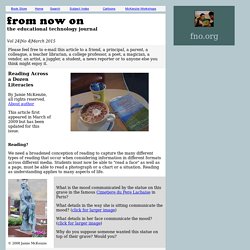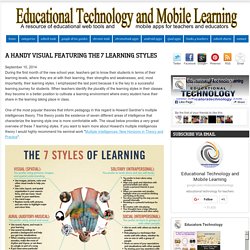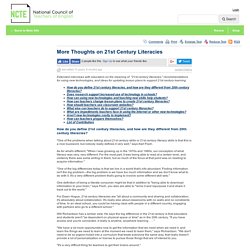

For Students 2016. 20 14 ISTE Standards S PDF. Proxy Login - University Libraries - USC. Standards & Learning - South Carolina Department of Education. Reading Across a Dozen Literacies. This article will define each literacy while giving examples of "reading" within each category.

It takes special skills to read a swamp or a beach or a desert area. These skills also differ from region to region as the flora and fauna shift. Most of us have heard of swimmers caught in rip tides because they did not know how to read the signs or of visitors enjoying tidal flats suddenly swept up in an incoming tide much larger than anything they knew back home. Artistic Literacy Anyone can look at a painting, a photograph or a movie. But looking, commenting, listening or sitting do not automatically translate into understanding. One can learn to read a photograph - understand its elements and interpret its meanings. Apply your own interpretive skills to this photograph by Rosie Hardy, Seven Deadly Sins, Pride : What choices did this photographer make in setting up the image?
Students will observe and make personal decisions about abstract artworks using a four-step critique process: 1. 2. 3. A Handy Visual Featuring The 7 Learning Styles. September 10, 2014 During the first month of the new school year, teachers get to know their students in terms of their learning levels, where they are at with their learning, their strengths and weaknesses, and, most importantly, their learning styles.

I emphasized the last point because it is the key to a successful learning journey for students. When teachers identify the plurality of the learning styles in their classes they become in a better position to cultivate a learning environment where every student have their share in the learning taking place in class. One of the most popular theories that inform pedagogy in this regard is Howard Gardner's multiple intelligences theory. This theory posits the existence of seven different areas of intelligence that characterize the learning style one is more comfortable with.
The visual below provides a very great overview of these 7 learning styles. Source: Blue Mango Learning. More Thoughts on 21st Century Literacies. Extended interviews with educators on the meaning of "21st century literacies," recommendations for using new technologies, and ideas for updating lesson plans to support 21st century learning.

How do you define 21st century literacies, and how are they different from 20th century literacies? "One of the problems when talking about 21st century skills or 21st century literacy skills is that this is a nice buzzword, but nobody really defines it very well," says Karl Fisch. As for what's different: "When I was growing up in the 1970s and 1980s, our conception of what literacy was very, very different.
For the most part, it was being able to read at a certain level, and certainly there was some writing in there, but so much of the focus at that point was on reading to acquire information. " "One of the big differences today is that we live in a world that's info-abundant. Will Richardson has a similar view. "It's a very difficult thing for teachers to get their brains around. " Contributors. Framework for 21st Century Learning. The NCTE Definition of 21st Century Literacies. Updated February 2013Adopted by the NCTE Executive Committee, February 15, 2008 Literacy has always been a collection of cultural and communicative practices shared among members of particular groups.

As society and technology change, so does literacy. Because technology has increased the intensity and complexity of literate environments, the 21st century demands that a literate person possess a wide range of abilities and competencies, many literacies. These literacies are multiple, dynamic, and malleable. As in the past, they are inextricably linked with particular histories, life possibilities, and social trajectories of individuals and groups. This position statement may be printed, copied, and disseminated without permission from NCTE.